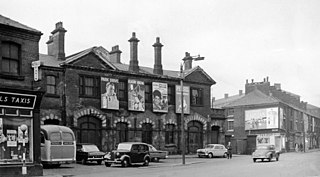The Bolton and Leigh Railway (B&LR) was the first public railway in Lancashire. It opened for goods on 1 August 1828, and thus preceded the Liverpool and Manchester Railway (L&MR) by two years. Passengers were carried from 1831. The railway operated independently until 1845 when it became part of the Grand Junction Railway.
The Manchester and Wigan Railway refers to a railway in North West England, opened in 1864 and closed to passengers on 3 May 1969, which was part of the London and North Western Railway before the Grouping of 1923. This route was an alternative to the surviving route through Swinton, Walkden and Atherton.

Bolton Great Moor Street railway station was the first station in Bolton. It was opened on 11 June 1831 by the Bolton and Leigh Railway.
Atherleigh railway station served an area of Leigh in what was then Lancashire, England. It was located on the Bolton and Leigh Railway line which ran from Kenyon Junction to Bolton Great Moor Street.
Atherton Bag Lane railway station served the town of Atherton, Lancashire, England. It was located on the Bolton and Leigh Railway line which ran from Bolton Great Moor Street to Leigh Station and the Leeds and Liverpool Canal and later to Kenyon Junction.
Walkden Low Level railway station served the town of Walkden, City of Salford, Greater Manchester, England.

Little Hulton railway station served the village of Little Hulton, Greater Manchester, England.
Howe Bridge railway station, originally Chowbent station, is a former railway station in Atherton, Greater Manchester. It was situated within the historic county of Lancashire.
Kenyon Junction was a railway station at Kenyon near Culcheth in Warrington, England. The station was built at the junction of the Liverpool and Manchester Railway and the Kenyon and Leigh Junction Railway. It was situated in the historic county of Lancashire. The station opened in 1830 as Bolton Junction and closed to passengers on 2 January 1961 before closing completely on 1 August 1963. The junction fell out of use when the line serving Leigh was closed in 1969.
Pennington railway station served Pennington, Leigh, Greater Manchester, England on the Bolton and Leigh Railway. It was situated within the historic county of Lancashire.
Westleigh or West Leigh was a station in Leigh, Greater Manchester, England on the Bolton and Leigh Railway line. Westleigh was situated within the historic county of Lancashire. Its station opened in 1831 and closed in 1954.
Chequerbent railway station was in Westhoughton to the south-west of Bolton, Greater Manchester, on a deviation of the original Bolton Great Moor St to Kenyon Junction line. The station replaced an earlier station on the original line of the railway that had been served by a stationary engine. It was open from 1885 until 1952 for passengers and 1965 for freight.
Plodder Lane railway station served the southern part of Bolton and the western, Highfield, part of Farnworth.
Chequerbent railway station was a railway station in Westhoughton to the south-west of Bolton, Greater Manchester, on the line between Bolton and Leigh. It was open from 1831 until its replacement in 1885 by a later station.
Hindley Green railway station is a closed railway station in the Hindley Green area of Wigan, England, where Leigh Road bridged the line.
Bolton Crook Street passenger station was a purely temporary facility within the Bolton Crook Street goods yard, devised by the LNWR for use while their nearby Great Moor Street station was demolished and rebuilt. It was used as such from August 1871 to September 1874, after which it reverted to use solely for goods.
Daubhill railway station was a station on the original route of the Bolton and Leigh Railway. It served the Daubhill area of south west Bolton. It was open from 1831 until its replacement in 1885 by a later station.
Plodder Lane engine shed was built by the LNWR to coincide with expanding its operations in the Bolton area in the 1870s and in particular the opening of a direct route from Bolton Great Moor Street station to Manchester via Walkden in 1875.
The Kenyon and Leigh Junction Railway (K&LJR) was constructed to link the Bolton and Leigh Railway (B&LR), which terminated at the Leigh Branch of the Leeds and Liverpool Canal, with the Liverpool and Manchester Railway (L&MR) at Kenyon.

